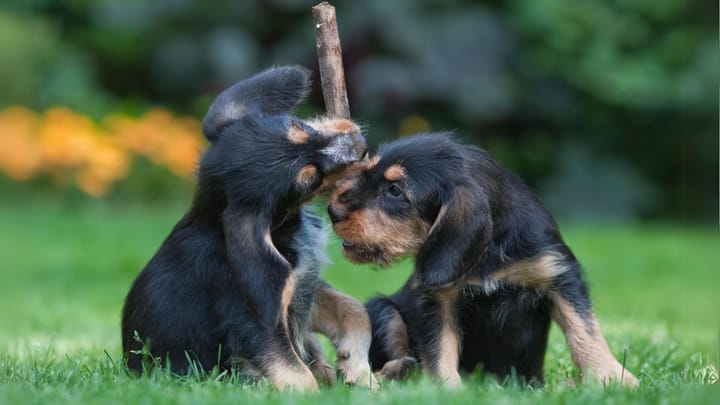Otterhound


The Otterhound is a big, lively and slightly boisterous dog who can make a wonderful family companion for those who can dedicate time to training and exercise. This breed is generally friendly, warm and relaxed. As lovely as they are, they’re not the type of dog who will be glued to your side and they do value independence.
The Otterhound was originally bred to hunt otters, though this has since (and rightly so) been deemed illegal. However, largely due to this ban, it’s estimated that there’s now less than 1,000 Otterhounds in the world.
|
Life expectancy |
The Otterhound has a life expectancy of between 10 and 12 years |
|
Temperament |
|
|
Size |
Large
|
|
Adult size |
Female
Between 26 and 30 in
Male
Between 24 and 26 in
|
|
Adult weight |
Female
Between 66 and 88 lb
Male
Between 66 and 88 lb
|
|
Coat colour
All colours are possible. The Otterhound coat can be black, black and white, black and tan, black and blue, liver and tan, red, grizzle or grizzle and white. The most common, though, would be black and tan grizzle. |
Black White Brown Blue Red Sand |
|
Type of coat
The Otterhound has a very thick, rough, double coat. It’s extremely weather-resistant, with the hardy undercoat able to absorb an impressive amount of water. The outer coat is dense and rough, though hair on the head is softer. |
Long Hard |
|
Eye colour
This breed’s eyes range from hazel to black, depending on, and complimenting, the coat colour. |
Blue
Green
Brown
Odd-eyed
|
Thanks to its oily dress and webbed feet, the Otter Dog can swim for 5 hours in pursuit of prey in the water.
More details about the Otterhound
Otterhound: Origins and history
Otterhounds date back as far as the 13th century, when King John kept an entire pack for hunting. Edward II subsequently became the ‘Master of Otterhounds’ and Elizabeth I the ‘Lady Master of Otterhounds’.
Otterhounds were particularly popular in 19th century Britain, but quickly decreased in number once the otter hunting ban was implemented in 1978. Now, they’re few and far between - there’s thought to be less than 1,000 left in the world!
Physical characteristics of the Otterhound
The Otterhound is definitely unique in terms of appearance, boasting webbed feet, thick, ‘scruffy’ coats and a charming, rustic appearance. This is a large, powerful dog with strong limbs, torso and back.
The head is big (huge, even) while the muzzle is long and wide. The face has long hair dropping off it, adding to the charm. Eyes are deep-set and the ears are long and flop down the sides of the face. The tail is reasonably thick and high-set.
FCI classification of the Otterhound
-
Group 6 - Scent hounds and related breeds
-
Section 1 : Scent hounds
Otterhound: Characteristics
Otterhound: Behaviour
Training a Otterhound
Thanks to the stubborn and independent traits, training the Otterhound can be tricky.
Due to their large size and sheer power, dedicated training is absolutely necessary and may take time. Start young and keep sessions short, fun and enticing by including plenty of rewards and positive reinforcement. This breed is also a good candidate for clicker training.
Otterhound: Lifestyle
Breed compatibility Otterhound
Otterhound: Purchase price
The Otterhound is a rare occurrence these days, so it’s hard to know how much they’d cost in the current climate. You’ll be on a long waiting list to get one - be prepared to part with upwards of £700 for a well-bred puppy.
Looking after a dog of this size typically costs between £60 to £110 a month, including food, medical/insurance, and incidental expenses.
Otterhound: Shedding
Average
The Otterhound is a moderate shedder, but regular brushing can help to minimize the mess.
Otterhound: Grooming
Due to their shaggy, thick coat, the Otterhound should be brushed at least once a week to avoid matts and tangles. Be careful - the Otterhound can quickly become a matted mess!
They’re messy dogs, meaning their beard will need a daily wash to get food and dirt out. However, they don’t need regular bathing - only do so when absolutely necessary.
Otterhound: Health
On average, the Otterhound lives for 11 years.
The Otterhound is powerful, strong and sturdy, although he does have the usual concerns for a dog of this size.
The Otterhound may enjoy the occasional bout of sunshine but will struggle in extreme heat. Make sure they have access to ice water and a cold room - their thick coat isn’t suited to heat. During warm spells, you’ll probably notice they’re more lethargic.
This breed has an impressively weather-resistant coat and can tolerate damp, cold and windy weather. That being said, he will appreciate warmth during cold winter nights.
The Otterhound’s great energy will allow him to maintain good form.
- Hip dysplasia
- Elbow dysplasia
- Bloat
- Allergies
- Sebaceous Cysts
- Bleeding disorders (thrombocytopenia)
- Lymphoma
- Epilepsy
- Cataracts



